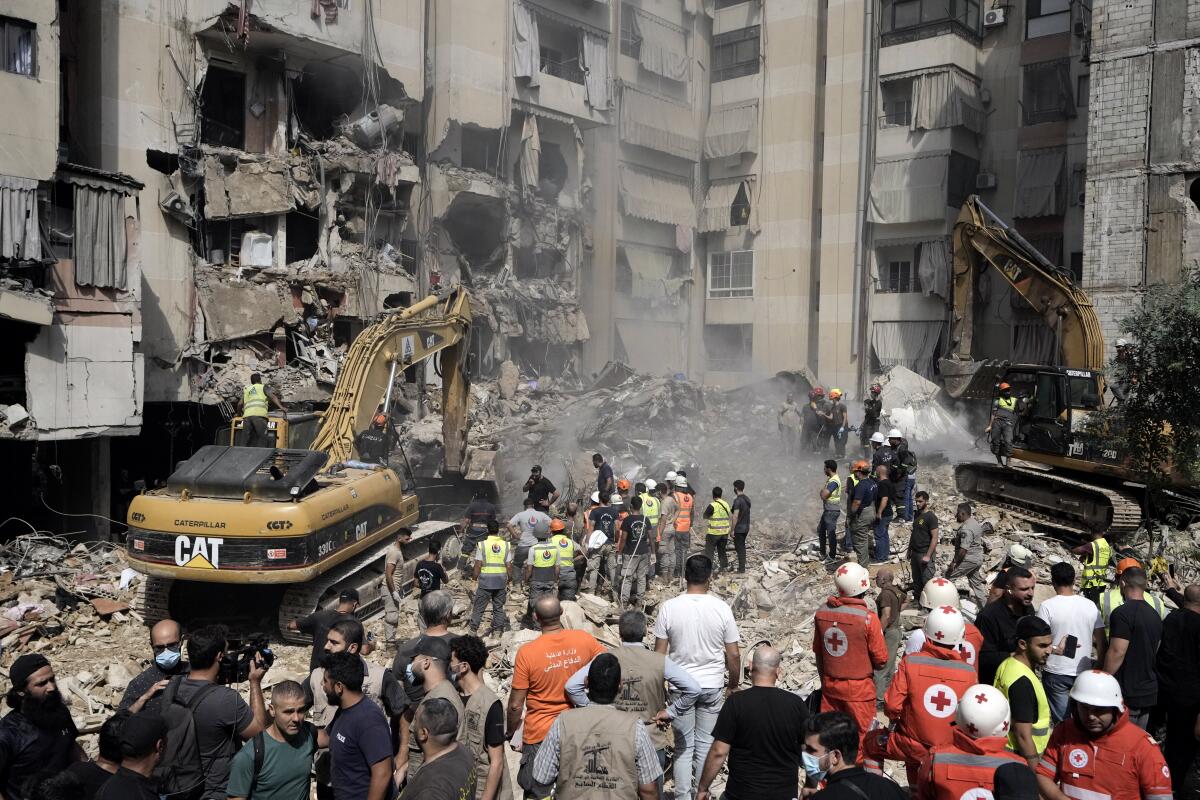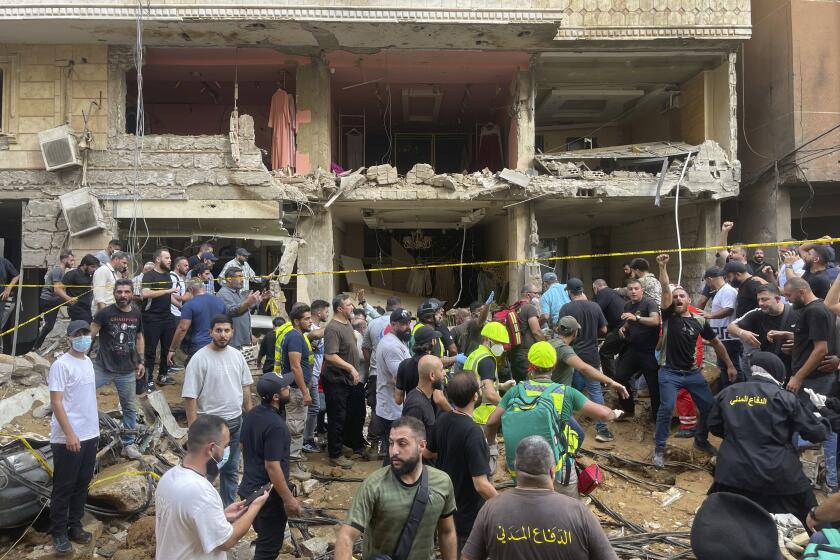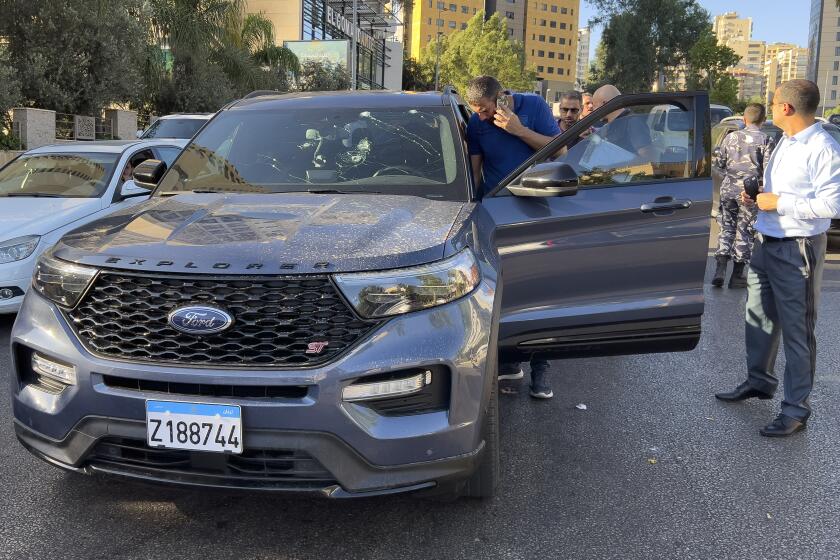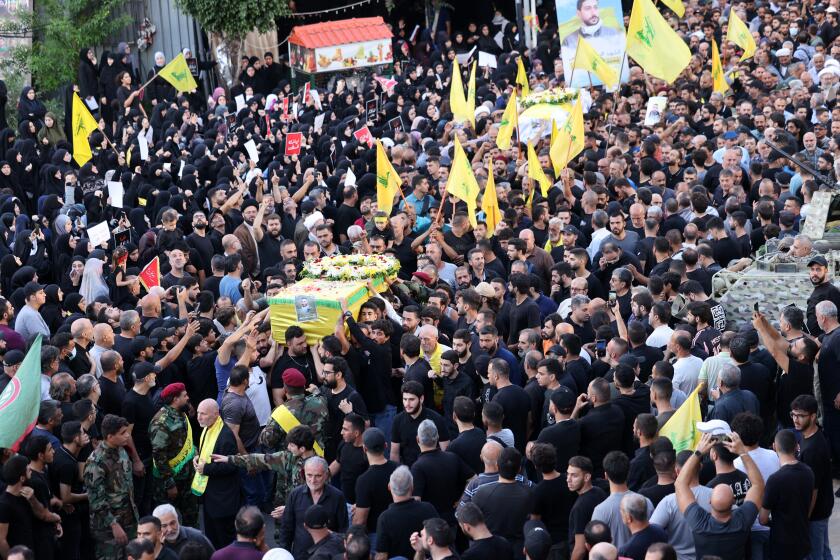Death toll in Beirut strike rises to 37 as Israel-Hezbollah trade barrages near Lebanon border

BEIRUT — As rescue crews continued to recover the last bodies of the victims of Israel’s strike in Beirut, Israeli warplanes launched a withering attack on Lebanon’s south, punctuating a week in which exploding pagers, bombardments and calls for revenge amplified fears of a wider regional war.
By Saturday, the number killed in Friday’s airstrike in a crowded suburban block in the Lebanese capital had risen to 37, according to the health ministry. It was the deadliest strike on Beirut in decades. Lebanon’s caretaker health minister, Firas Abiad, said at a news conference that the dead included seven women and three children and that an additional 68 people were wounded. With many still missing, the death toll is expected to rise.
Hezbollah claimed 16 of those killed as its operatives and said others were civilians. A day earlier, the group acknowledged the death of one of its most senior leaders, Ibrahim Akil, who created its elite Radwan force. Israel said it targeted Akil and other Hezbollah leaders. Ahmad Wehbi, head of the commando group, was also killed. Akil had become Radwan’s operations chief following the killing of another senior commander in an airstrike on Beirut almost two months ago.
On Saturday, White House national security advisor Jake Sullivan said Akil’s death was “a good outcome.” In 2015, the U.S. placed a $7-million bounty on Akil’s head for his role in the twin bombings in 1983 on the U.S. embassy in Beirut and U.S. Marine barracks, which collectively killed 370 people. Sullivan said Akil had “American blood on his hands.”
Days after the attacks on Hezbollah with exploding electronic devices across Lebanon, Israel has struck a suburb of Beirut, killing a top commander.
Israel and the Iranian-funded Hezbollah have traded fire in an escalating tit-for-tat since Oct. 8, a day after Hamas militants’ deadly assault on southern Israel and the ferocious Israeli offensive in the Gaza Strip that followed. Hezbollah says it aims to compel Israel into a cease-fire with Hamas. Friday’s strike in Beirut came after an intense Hezbollah bombardment of northern Israel, which was mostly intercepted by Israel’s defense systems, the Israeli military said.
On Saturday, journalists were allowed to tour the attack site in Beirut. Rescue workers, wreathed in smoke, stood by a pair of excavators digging through a mountain of rubble — the wreckage of an eight-story, 16-apartment building.
The blast also cut through a second building, where Hezbollah officials were reported to be meeting in a basement, according to Israel. That building still stood, but the walls on the second floor were sheared off. One apartment, painted in pink, was a dress shop, with dust-covered gowns still hanging from clothes racks. A nearby sign read “Dress like you’re already famous.”
Residents and family members continued their vigil, waiting for news of their missing loved ones. Some sat on plastic chairs out on the street, alternating between sobbing and silence. Others massed near an entrance to the blast area and watched Red Cross workers bringing stretchers to take out the bodies.
“We have six dead in our family. Three are already out, three still under the rubble,” said Mohammad, a 21-year-old from a nearby neighborhood who was waiting on the sidewalk. Like others interviewed, he feared harassment from other residents for speaking with Western media and asked that only his first name be used. Two of the missing were children, a 15-year-old and a 4-year-old, he added.
Up the street, five abaya-clad women comforted another woman, who repeatedly shouted, “They’re all martyred!”
The airstrike capped a devastating week for Hezbollah. On Tuesday and Wednesday, thousands of pagers and walkie-talkies used by the group’s fighters, officials and administrators detonated, killing 37 — including two children — and leaving thousands with wounds to eyes, hands and torsos.
Targeting thousands of people by weaponizing ordinary communication devices violates international human rights law, the United Nations human rights chief said Friday after the attacks. Volker Turk, at a U.N. Security Council emergency meeting, called for an independent investigation and said those responsible “must be held to account.”
Israel has not claimed responsibility for the assaults via the wireless devices but is widely believed to have orchestrated them.
Thousands of people were wounded across Lebanon in what was thought to be a cyberattack causing pagers carried by Hezbollah members to explode.
Cross border strikes continue
On Saturday, Israeli warplanes conducted dozens of airstrikes on south and east Lebanon, authorities said, adding that the barrage was more intense than previous attack waves. Israel said it was attacking Hezbollah targets. Hezbollah announced it conducted attacks on several military sites in north Israel.
The ongoing attacks across the Israel-Lebanon border have forced some 90,000 people in south Lebanon to flee their homes and displaced 60,000 in northern Israel. Israel’s security Cabinet announced in recent days that stopping the attacks in the north so that residents can return to their homes there is now an official war goal.
Rear Adm. Daniel Hagari, an Israeli defense spokesperson, said Saturday that safety guidelines had been updated north of Haifa, where gatherings of more than 30 people in open spaces and 300 in enclosed spaces are now prohibited.
Lebanon wracked by fresh wave of explosions of booby-trapped communication devices believed to be part of an electronic sabotage campaign against Hezbollah.
Hezbollah leaders insist they will not stop their rocket campaign until a cease-fire is enacted in Gaza. But Israel’s recent escalation has increased pressure on the group, which was created with Iranian support in 1985 and has since grown into a sprawling military-civilian organization and one of Lebanon’s most powerful political parties.
It built its reputation as the most effective Arab armed force during Israel’s 18-year occupation of Lebanon’s south, when Lebanese Shiite guerrillas — including Akil — conducted an insurgent campaign that forced the Israeli military to withdraw in 2000. In 2006, a 34-day war between Israel and Hezbollah left wide swaths of Lebanon destroyed but the militant group intact.
The memory of that devastation has remained paramount in the mind of Lebanese people, with many fearing that an all-out war now would ravage a country already plagued with a years-long economic crisis.
Hezbollah has seemed unexpectedly vulnerable in the wake of Israel’s recent attacks, with little in the way of a response that would mollify its internal base. In a speech Thursday, Hezbollah chief Hassan Nasrallah said retaliation was coming, but did not elaborate.
Many of the group’s supporters believe the time for all-out war has come.
“The sayyid cares about our welfare but we’re ready,” said Kayed, a resident of the targeted neighborhood who asked to be identified by only his first name to avoid harassment for speaking with Western media. He referred to Nasrallah by his honorific.
“I pray to Allah that the strike will make the sayyid lose his patience.”
The Associated Press contributed to this report.
More to Read
Sign up for Essential California
The most important California stories and recommendations in your inbox every morning.
You may occasionally receive promotional content from the Los Angeles Times.














